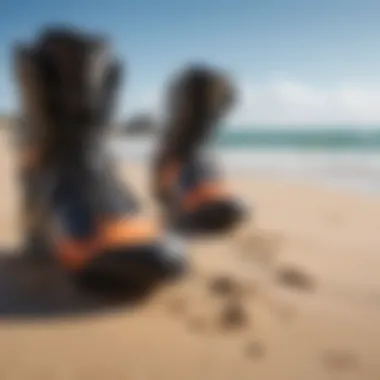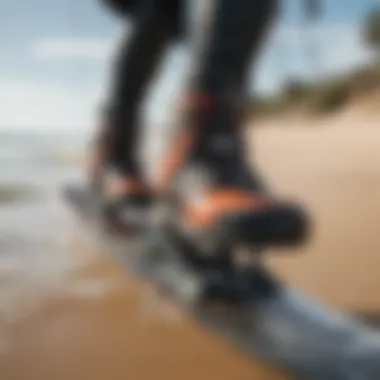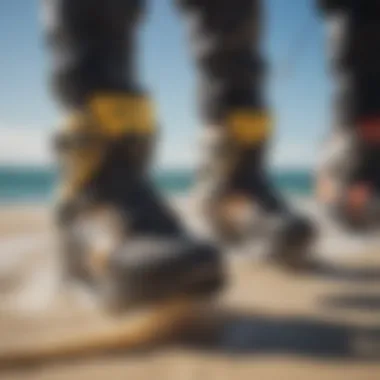Essential Guide to Kitesurfing Booties and Performance


Intro
Kitesurfing is a thrilling sport that marries the elements of wind, water, and adrenaline. While plenty of attention often goes to the kite and board, one of the unsung heroes of the kitesurfing experience is the kitesurfing booties. These specialized footwear pieces serve a variety of functions, ensuring comfort, security, and performance when riding the waves. Understanding the nuances of what makes a good kite bootie is crucial for both novices looking to get started and seasoned veterans aiming to refine their skills.
In this article, we’ll peel back the layers on kitesurfing booties, examining their material composition, exploring the benefits they offer, and delving into the impact they can have on your overall performance on the water. We’ll also provide handy tips on selecting the right pair and keeping them in top condition. Kitesurfers must be equipped with the right knowledge to enhance their kiteboarding experience across different environments.
Gear Insights
Latest Gear Reviews
When it comes to kitesurfing booties, the market is brimming with options. Each brand has its unique take on design, functionality, and price point. Identifying these differences is key to making an informed choice. A few notable models that stand out currently include:
- Ion Strike Booties: Known for their durable construction and warm insulation, these booties are great for colder waters. They strike a balance between flexibility and protection, making them a favorite among many.
- Ozone Wakestyle Booties: These offer superior grip and stability without sacrificing flexibility, enabling advanced maneuvers while keeping your feet secure.
- Mystic Marshall Booties: With an easy-entry design, these booties cut the fuss of getting them on and off. Their design provides excellent insulation and comfort, suitable for a range of conditions.
Essential Gear for Beginners
For those just starting in kitesurfing, the essentials outline how best to navigate the waters safely. Choosing the right booties can make a world of difference:
- Material: Look for flex materials that offer warmth without being too rigid. Neoprene generally serves this purpose well.
- Fit: Ensuring a snug fit is crucial as this prevents foot fatigue and instability.
- Traction: A good grip matters, especially while jumping or making quick turns. Booties with a textured sole are beneficial.
- Price Point: There are many options for every budget. Investing in quality gear can save you money in the long term by enhancing your performance.
With the right booties on your feet, even a beginner can take to the waves with confidence, feeling secure and well-prepared.
Techniques and Tips
Advanced Tricks and Techniques
For those comfortable with kitesurfing, achieving advanced maneuvers requires not only skill but also the right gear. Booties can facilitate a host of actions, such as:
- Jumping: Proper grip boosts your propulsion off the board.
- Spins: Engaging your feet and maintaining stability helps in seamless turns and flips.
- Sliding: A well-designed sole enhances control during tricks like slides and grinds.
Safety Practices for Kiteboarders
Safety is paramount in kitesurfing, and your booties can be a part of that equation. Pay attention to-don’t forget to:
- Inspect your booties regularly for wear and tear.
- Ensure they fit correctly to prevent foot injuries.
- Use booties with reinforced toe and heel areas to avert injuries from sharp debris.
“The right kitesurfing booties can be your unsung partner, ensuring your joy on the water is matched by your safety and performance.”
By understanding booties' role in kitesurfing, you arm yourself with the necessary tools to perform at your best while enjoying the sport. Whether you're just dipping your toes in or pulling off that tricky maneuver, the right gear will set the stage for plenty of memorable moments on the waves.
Understanding Kitesurfing Booties
Kitesurfing is more than just a thrilling glide across the water; it demands a unique set of equipment to make the experience safe and enjoyable. One element that often doesn’t get the spotlight it deserves is kitesurfing booties. These aren’t just accessories but are vital components of one's kitesurfing gear. Understanding the ins and outs of kitesurfing booties helps in enhancing performance while also ensuring safety during each session on the water.
When it comes to kitesurfing, the right foot protection can make all the difference. These booties play several roles: they safeguard our feet from sharp shells or rocks that litter the seabed, provide thermal insulation against chilly waters, and improve grip on the board. It might seem trivial, but slipping off your board at the wrong moment due to inadequate grip can ruin the fun and even lead to accidents. Therefore, one needs to consider models that offer durability without compromising on comfort.
Definition and Purpose
Kitesurfing booties are specialized footwear designed specifically for use in kitesurfing. They often feature extra padding, grip soles, and materials that withstand the marine environment. The main purpose of these booties is to protect not just the feet but to add to overall performance while kitesurfing.
You might wonder why not just use any kind of shoe? Well, those casual water shoes can’t handle the rigors of kitesurfing. They lack the proper buoyancy and firmness required to keep your feet aligned and steady as you maneuver against both water and wind. Kitesurfing booties are engineered to provide the right amount of flexibility while giving you that essential feedback from your board. It translates to better control whether you are carving tight turns or catching air.
Historical Context
The evolution of kitesurfing booties is a fascinating journey. It all began when surfers recognized the need for better foot protection as the sport grew in popularity. Initially, makeshift solutions from old wetsuits or skate shoes were common. However, by the late 1990s, surf brands began to design dedicated booties that addressed specific challenges faced by kitesurfers.
These early versions were simple, often crafted from the same materials as wetsuits, focusing mainly on warmth. Fast forward to today, and technology has crafted booties that not only keep your feet warm but also offer unparalleled comfort, grip, and durability. This innovation reflects a broader trend in the kitesurfing gear industry, prioritizing athlete performance. Companies have invested in advanced materials to create footwear that works harmoniously with the water and the board.
"Kitesurfing booties have transitioned from simple protection to essential performance enhancers."
The journey of kitesurfing booties illustrates how vital they have become in adapting to the changing needs of kitesurfers around the globe. Understanding their significance adds value to one's kitesurfing experience, ensuring enthusiasts can navigate waves and winds with confidence.
Types of Kitesurfing Booties
Understanding the different types of kitesurfing booties is crucial for anyone serious about the sport. Each kind offers its own set of benefits and considerations which greatly impact performance on the water. Choosing the right type can mean the difference between a day of smooth riding and one of discomfort or even injury. As such, it’s worth digging into the specifics of these booties to make an informed decision based on your kitesurfing style, local conditions, and personal preferences.
Full Booties
Full booties provide comprehensive coverage and are typically made from flexible neoprene material. These booties envelop the entire foot, providing warmth and protection up to the ankle. Relying on a solid fit, they often feature a strap around the ankle or an integrated seal that keeps water from seeping in.
The benefits of full booties are quite apparent, especially in colder water conditions. They are great for maintaining body warmth when the temperature dips, allowing the rider to focus solely on their performance rather than the chill. Moreover, they offer protection against sharp rocks, shells, and other underwater hazards, making them suitable for rocky or reef-heavy locations.
However, it's essential to ensure that the fit is just right. If full booties are too tight, they can become uncomfortable. Conversely, if they are loose, they may lose their insulating properties, resulting in water pooling inside. What’s more, the thickness of the neoprene can also vary, affecting overall comfort and flexibility.
Slipper Style Booties
Slipper style booties, or simply "slippers," are a more minimalist option. They cover the bottom of the foot and often have a lighter neoprene construction. Unlike full booties, they leave the ankles exposed.
This style is particularly favored in warmer conditions where water temperatures are less of an issue. Their lightweight design often improves the rider’s feel for the board, enhancing maneuverability. One of the most significant advantages of slipper style booties is their ease of entry and exit. Kiteboarders can quickly slip them on and off before and after sessions without the struggle associated with some full models.
While they shine in warmer waters, they lack the insulation and protection that full booties offer. Hence, it's paramount to consider the typical conditions where you’ll be kitesurfing. If you often deal with rocky shores or sharp coral, slipper style may not provide the necessary defense.
Neoprene Booties
Neoprene is the common thread among all types of kitesurfing booties. However, when referring to neoprene booties, one might be talking about specific styles that heavily rely on varying thicknesses and structural innovations within the neoprene fabric itself.
These booties can come in different types, such as full or slipper design. What sets them apart is the variety of neoprene materials used. Some are designed for flexibility and lightweight properties, while others prioritize thermal insulation or durability.
As a rule of thumb, thicker neoprene tends to provide better insulation but might reduce the overall mobility on the board. Conversely, thinner options offer a more tactile experience but may not withstand the rigorous demands of harsher conditions.
Choosing neoprene booties can come down to personal preference related to climate, environmental factors, and your level of experience. "The right booties can elevate your kitesurfing experience, providing the balance of comfort, protection, and performance that every rider needs."


Materials Used in Booties
When it comes to kitesurfing booties, the materials used are crucial. They affect every aspect, from comfort and performance to durability and temperature control. An intelligent choice regarding materials can lead to a better overall kitesurfing experience, helping riders enjoy their time on the water while staying safe and comfortable.
Neoprene Composition
Neoprene is the backbone of most kitesurfing booties. This versatile material is not just any old rubber; it’s specifically designed to provide insulation and flexibility. It responds well to different environmental conditions, making it suitable for a range of climates.
Neoprene comes in varying thicknesses, usually ranging from 2mm to 7mm, which can affect insulation capabilities. For instance, the thicker compositions give extra warmth in colder waters, while thinner options allow for increased dexterity. Riders can feel the board better with less material in the way, enhancing control and responsiveness. Use of high-quality neoprene can significantly cut down on chafing and irritation, which are common complaints among kitesurfers.
"Choosing the right neoprene thickness isn’t just about the warmth; it’s about the whole kitesurfing experience."
Thermal Properties
Thermal properties are essential for anyone engaging in kitesurfing, especially in chilly waters. Good booties will help maintain body temperature by trapping a thin layer of water inside. This water is then warmed by body heat, creating a layer of insulation that keeps feet warm even when riding in cool conditions.
A drawback of low-quality booties is that they often lack effective heat retention.
• Heat Retention: The ability to keep warmth is vital in colder climates. • Cold Shock Resistance: The transition from warm air to cold water can be jarring; good thermal properties help mitigate this shock.
Moreover, some advanced models incorporate thermal linings to further enhance heat retention without sacrificing flexibility, ensuring that riders can move freely.
Durability Aspects
Durability is another key consideration in bootie materials. Kitesurfing involves high physical demands, with constant exposure to saltwater and abrasive surfaces. Low-quality options will deteriorate fast, leading to disappointing performance and potential safety hazards.
A well-constructed bootie made of high-grade neoprene, reinforced stitching, and a robust sole provides:
- Enhanced Longevity: Booties that can withstand the rigors of kitesurfing last much longer, making them a smarter investment over time.
- Resistant to Tears and Abrasion: The bootie's materials should resist damage from sharp objects and wear.
- Adaptability to Different Conditions: Quality materials will retain their shape and integrity, whether surfing in shallow coral-infested waters or riding the waves in an open ocean.
In summary, understanding the materials used in kitesurfing booties is wholesome for any kiteboarder. From the core composition of neoprene to thermal properties that regulate temperature, and the durability that withstands challenges, each aspect plays an important role in your experience. This knowledge not only improves performance but enhances safety and enjoyment, leading to more time on the water.
Benefits of Using Booties in Kitesurfing
When it comes to kitesurfing, the equipment you wear can make or break your experience on the water. Among the essentials, kitesurfing booties stand out for several compelling reasons. They aren’t just fashionable; they provide critical benefits that enhance both comfort and performance during your sessions. Let’s delve into the specific advantages that these booties bring to the table.
Enhanced Grip
One of the most significant benefits of kitesurfing booties is the enhanced grip they provide. The surfaces of these booties are usually designed with a rubberized sole that offers superior traction, allowing your feet to firmly grip the board when conditions get wild. No kiteboarder wants to lose their footing mid-maneuver, especially when attempting complex tricks or navigating choppy waters. By offering a stable base, booties can help reduce the chances of slipping off, empowering you to confidently take on challenges.
Moreover, the grip isn’t just about performing stunts. It also enhances safety. If you lose balance in rough surf, those booties can hold your feet in place, minimizing the risk of injuring yourself or falling awkwardly. In a sport where every fraction of a second counts, having that added control can be a game changer.
Improved Temperature Regulation
Temperature plays a notable role in kitesurfing, particularly in colder waters where exposure can lead to discomfort or even hypothermia. Kitesurfing booties are crafted primarily with neoprene, a material known for its insulating properties. This allows you to maintain a comfortable temperature, keeping your feet warm while you ride.
On chilly days, the right thickness of neoprene can make all the difference. Generally, thicker booties mean better insulation, but this can also depend on personal preference and specific conditions. For instance, if you typically kite in the warmer months, opting for thinner booties may provide the balance needed for mobility without sacrificing feel.
It’s also worth noting that improved thermal regulation doesn’t just apply in cold conditions. Some booties manage to regulate temperature during warmer days as well, preventing overheating and ensuring you can focus solely on your performance. This adaptability to varying temperatures underscores the necessity of selecting the right booties as part of your gear.
Protection from Sharp Objects
Lastly, kitesurfing often involves navigating through unpredictable environments where sharp objects may lurk beneath the surface. Stony beaches, hidden reefs, or even just barnacles can pose serious risks to an unprotected foot. Kitesurfing booties act as a protective barrier, safeguarding your feet from potential injuries.
In addition to rocks and reefs, booties also offer some level of insulation against stings from jellyfish or cuts from sharp shells. The longer the bootie covers your ankle, the more secure you’ll feel wading through those sketchy tidal pools or tackling new spots. It’s like arming yourself with a defender while you pursue the thrill of riding.
Overall, kitesurfing booties are not just footwear; they are essential gear that enhances performance, safety, and comfort.
As you contemplate your own kitesurfing adventures, think of booties less as an optional accessory and more as a crucial part of your overall kit. Not only will they provide benefits in grips, warmth, and protection, but they may also end up being a defining factor in your kitesurfing experience, shaping each ride you take.
Choosing the Right Booties
When it comes to kitesurfing, the right pair of booties can make or break your experience on the water. Choosing them isn't just about looking at brands, colors, or even price tags; it’s about considering numerous factors that affect comfort, performance, and safety in varying conditions. Let's dive deeper into what makes choosing the right booties so crucial.
Size and Fit Considerations
Finding the perfect size and fit is not just about your foot measurement. It’s an art that involves understanding how your booties will behave once you're out on the waves and whether they provide enough flexibility for your movements. Booties that are too tight can cause pressure points, while loose ones might be cumbersome and impede your responsiveness on the board.
- Try Before You Buy: Always try them on with the socks you'll be wearing to simulate actual usage.
- Movement Check: Bend your ankle and try to mimic movements you’d perform while kitesurfing. This gives insight into how well they will adapt to your style.
- Consider Arch Support: Depending on your foot's arch, you may need additional support, so look for booties with customizable insoles.
Taking these steps helps ensure your chosen booties fit like a glove.
Thickness Variations
Kitesurfing booties come in various thicknesses, generally ranging from 2mm to 7mm. Each thickness serves a different purpose and is ideal for different environments.
- Thinner Booties (2-3mm): These are perfect for warm waters, allowing for more flexibility and feel on the board. They tend to dry faster, making them suitable for frequent use in temperate conditions.
- Medium Thickness (4-5mm): These provide a balance of warmth and mobility. Ideal for transitional seasons when the water gets a bit chilly but you still want to maintain some board feel.
- Thicker Booties (6-7mm): Suitable for colder environments, these offer substantial insulation. If you're braving frigid waters, they keep your toes from turning into ice cubes, but they might sacrifice some freedom of movement.
So, choosing the right thickness isn’t just about comfort—it's about performance on the waves.
Sole Design Preferences
The sole design of kitesurfing booties can significantly impact your grip and overall handling on the board. The soles come in a range of styles, each designed with specific purposes in mind.
- Flat Soles: These provide maximum board feel and responsiveness, allowing you to connect better with your board. However, they might not offer ample support on rocky or difficult terrains.
- Textured or Gripped Soles: Designed for enhanced traction, they prevent slipping inside the booties. This can be vital when you're trying to maneuver in choppy waters.
- Stiff Soles: Some booties feature stiffer soles that ensure more support during aggressive riding. The trade-off might involve a slightly less maneuverable experience, so it's a matter of personal preference.
Keep in mind that finding the right sole design contributes significantly to your kitesurfing efficiency.
"Selecting booties is not merely a chore; it's a vital part of preparing for an exhilarating water adventure."
In summary, choosing the right kitesurfing booties involves a careful balance of fit, thickness, and sole design preferences. While keeping performance and comfort in mind, doing your homework on these factors will help in hand-picking the ideal pair that aligns with your riding style and the conditions you’ll face.


Maintenance of Kitesurfing Booties
Caring for your kitesurfing booties isn’t just a matter of keeping them looking nice; it’s about maintaining their functionality and extending their lifespan. Regular maintenance improves performance and ensures that you get the most bang for your buck, especially since quality booties can be quite an investment. Here, we'll delve into cleaning techniques, drying procedures, and storage practices that will keep your booties in tip-top shape.
Cleaning Techniques
Cleaning your kitesurfing booties is non-negotiable. After all, every time you hit the water, they collect sand, salt, and other residues which can wear them down over time. Here’s how to keep them shining like new:
- Rinse with Fresh Water
Always rinse your booties with fresh water after each session. This simple step helps remove salt and sand that can lead to wear and tear. Aim to do this right after you get back to shore; the sooner, the better! - Use Mild Soap
If your booties are particularly dirty, mix a bit of mild soap with water in a bucket. Use a soft brush to scrub away tougher spots. Be gentle, of course; you don’t want to scratch the material. - Avoid Harsh Chemicals
Store-bought cleaners can be tempting, but many contain harsh chemicals that may deteriorate neoprene or other materials. Stick to mild soap and water to maintain the integrity of your booties.
Drying Procedures
Just as crucial as cleaning are drying procedures. If you toss your wet booties into a garage corner, you're looking for trouble—mold, unpleasant odors, and even material damage. Here’s the lowdown on how to properly dry your booties:
- Air Dry
Never throw your booties in the dryer; it can ruin the fit and flexibility. Instead, hang them up in a well-ventilated area away from direct sunlight. Too much sun exposure can cause the material to degrade over time. - Sock Drying
For booties made of neoprene, a juicy tip is to insert a clean towel into the toe area. This helps absorb moisture and speeds up the drying process. Just remember to remove the towel after a few hours! - Avoid Heat Sources
Never place your booties near heaters, radiators, or any other heat sources. The high temperatures can warp the materials, leading to a shorter lifespan.
Storage Practices
Last but definitely not least, how you store your booties can make a world of difference. Here are a few best practices to keep your booties fresh and ready for your next adventure:
- Store in a Cool, Dry Place
Find a spot that’s cool and dry for storage. Avoid damp or humid locations; moisture can lead to mold and other issues. - Keep Away From Weight
Storing your booties under heavy items will distort the shape over time. Always keep them lying flat or hanging to preserve their form. - Routine Check
Every now and then, do a little check-up on your booties during the off-season. Inspect for any signs of damage or wear. Catching issues early can save you from unpleasant surprises later on.
Taking care of your kitesurfing booties isn’t just an afterthought. It’s essential for the durability and performance of your gear. A little maintenance goes a long way.
Innovations in Kitesurfing Booties
In the fast-paced world of kitesurfing, keeping up with the latest innovations in bootie design and material is essential for both performance and safety. The advancements in kitesurfing booties not only enhance comfort but also contribute significantly to riders' overall experience on the water. With each wave and gust of wind, the right bootie technology can make a noticeable difference in maneuverability, durability, and thermal protection.
Emerging Materials
Recent years have seen a surge in the development of advanced materials that are revolutionizing kitesurfing booties. Traditional neoprene has undergone upgrades, and new blends have emerged, promising better flexibility and insulation. For instance, some companies have started using limestone-based neoprene instead of oil-based, which is seen as a more sustainable option that doesn’t sacrifice performance. This transition not only helps the environment but also improves the buoyancy of the booties.
Another exciting material is the use of recycled plastics. These materials are being utilized in making sustainable booties that are both functional and eco-friendly. This means that kitesurfers can enjoy their passion while making choices that are better for the planet. The high-quality performance of these materials is a game-changer in the sport, ensuring that wet conditions do not lead to a compromised experience.
Design Developments
When it comes to design, the evolution of kitesurfing booties has also not been standing still. It's all about the fit and functionality. One innovative trend is the development of custom-molded fit systems, which allow for a more personalized shape that hugs the foot better. This tailoring can lead to fewer blisters and increased comfort, letting kiteboarders focus on their craft rather than their gear.
Moreover, booties now feature additional padding and support structures that cater to tricks and high-impact landings. This can be particularly useful when riders are pushing the limits of their skills and need that extra coverage without sacrificing flexibility. Also, the addition of drainage systems means that water easily escapes, keeping the booties light and reducing fatigue during long sessions in the sea or lake.
Integration with Technology
As we move further into the tech era, some brands are exploring the realm of smart booties, integrating technology in ways that were previously unimaginable. From built-in sensors that track performance metrics to materials that adapt to temperature changes, the future seems bright for kitesurfing booties. Imagine a bootie that alerts you when you need to take a break due to fatigue or offers advice on improving your stance based on real-time analysis of your movements. Such technologies, while still in development, represent a thrilling frontier for competitive and casual kiteboarders alike.
"The evolution of kitesurfing booties is a testament to how technology continues to transform extreme sports, making it safer and more enjoyable for adventurers at all levels."
Looking ahead, it’s clear that innovations in materials, design, and technology not only aim at enhancing performance but also focus on sustainability and rider comfort. As the industry evolves, kitesurfing booties will play a crucial role in ensuring that kiteboarders can navigate and enjoy their passion while being mindful of environmental impact.
Common Misconceptions about Booties
Kitesurfing booties serve an essential role for kiteboarders, whether they're cutting through waves or catching that perfect breeze. However, misconceptions about these critical pieces of equipment can lead to poor decisions that diminish the overall kitesurfing experience. Understanding these common misconceptions can enhance awareness among both novice riders and experienced practitioners. By separating fact from fiction, kitesurfers can make informed choices about their gear, which will ultimately lead to better performance on the water.
Overestimating Comfort Needs
A common fallacy is that the most comfortable booties are always the best option for kitesurfing. While comfort is surely a crucial factor, it should not be the sole criterion when selecting booties. Many booties designed for kitesurfing prioritize durability and protection over plushness. Riders often find themselves tempted by cushioned booties that feel great when trying them on, but those may lack grip and stability in water.
What feels good on land is not necessarily going to perform the same way once you hit that surf.
"In kitesurfing, comfort should complement functionality. Look for booties that give both."
Adjustment to a snug fit can take time, especially if those booties are designed for performance. Booties should fit snugly yet comfortably without being so tight that blood flow is restricted. It's key for riders to recognize that after a bit of getting used to, a proper fit aids their connection to the board and enhances maneuverability.
- Key Considerations:
- Focus on grip and stability
- A snug fit may feel uncomfortable at first
- Comfort should not outweigh functionality
Assumptions on Cost vs Quality
Another prevalent misconception is that higher price tags guarantee better quality. While it’s true that you often find advanced technology in premium booties, it's a mistake to think that all expensive options will suit every rider’s needs. Kitesurfing booties significantly differ in design, material, and intended usage.
An entry-level bootie might deliver tremendous value for a beginner just starting without needing to break the bank. In many cases, what benefits one kitesurfer might not be the same for another.
Therefore, evaluating brands and models based on usability rather than price point is more valuable. User feedback showcases how a cheaper model can sometimes outperform a pricier one based on individual conditions and riding styles.
- Important Aspects to Evaluate:
- User feedback on performance
- Material quality and usability
- Intended conditions and rider experience level
In short, a rider should center their decision around quality features, personal preferences, and the specific challenges they might face on the water rather than assuming that cost equates to improvement.
By addressing these misunderstandings, kiteboarders can make more rational choices that align closely with their unique styles and needs.
How Booties Affect Kitesurfing Performance
Kitesurfing is a sport where the gear plays a vital role in shaping the overall experience. One often overlooked element is the booties. Proper booties do not just keep your feet warm; they have a substantial impact on your performance on the water. The right pair of booties can enhance maneuverability, and influence endurance, and thus, understanding their effects can elevate your kitesurfing sessions substantially.
Impact on Maneuverability
When you hit the waves, maneuverability can make or break your session. Booties significantly affect how you manage your board while kitesurfing. A snug fit is crucial here. If your booties are too loose, you might find your foot slipping inside them, preventing precise control over your board. Tight, yet comfortable, booties can enhance your foot's responsiveness, allowing you to make sharper turns and quicker movements.
You might wonder if the material plays a part. It sure does! A good grip on the sole of the bootie means you can plant your feet with confidence when pulling off tricks. Booties with textured soles provide that essential grip, allowing you to feel every slight adjustment in the board. Some brands even design soles that mimic the bare foot's anatomical structure. This becomes incredibly useful when you're in challenging conditions—tight turns, choppy waters, or when surfing behind a wake boat. An effective pair of booties gives you that additional edge, letting you climb maneuvering levels.


Influence on Endurance
Let’s talk about endurance, which cannot be underestimated in kitesurfing. The right bootie can mean a world of difference during long sessions on the water. Cold feet can be distracting, leading to discomfort that may make you want to call it quits sooner than planned.
Neoprene booties, known for their thermal insulation, are designed to keep your feet warm even in cooler waters. The right thickness provides insulation while preventing fatigue. A well-insulated bootie traps heat without being excessively bulky, allowing you to maintain your stamina for prolonged periods.
Furthermore, an uncomfortable fit can lead to blisters or sore spots, which can really put a damper on things. Choosing the right thickness and fit ensures that your feet feel fine throughout those long beach days or when you're navigating through unpredictable currents. Less discomfort means better focus and extending those exhilarating hours riding waves.
In summary, the right booties contribute significantly to both your maneuverability and endurance, making the choice of this piece of equipment less trivial than it appears.
Understanding these factors allows you to make an informed decision, helping elevate your kitesurfing experience to new heights.
Booties and Environmental Considerations
The topic of kitesurfing booties is not just about fit, comfort, and performance on the water. It’s also deeply intertwined with environmental mindfulness. As kiteboarding continues to grow in popularity, the environmental impact of gear like booties has come under scrutiny. This section uncovers the importance of considering the ecological footprints of materials used in booties and how this affects both users and nature.
Sustainability of Materials
When we look at the materials that make up kitesurfing booties, it’s essential to recognize that not all materials are created equal. Traditionally, many booties are produced with synthetic materials like neoprene, which, while effective for insulation and durability, often come from petrochemical sources. This raises concerns about non-renewable resource use and pollution during production.
Manufacturers are beginning to pivot towards materials that offer better sustainability profiles. For instance, some brands are experimenting with alternatives such as organic cotton, recycled plastics, or natural rubber. These materials not only reduce environmental harm but also tend to break down more easily at the end of their life cycle. By choosing booties made from sustainable materials, kiteboarders can lessen their ecological impact and make a more responsible choice.
Recycling Initiatives
Initiatives to promote recycling in the kitesurfing community are becoming more prominent. Some companies are now offering programs that allow customers to return old booties for recycling. This move fosters a culture of sustainability, encouraging users to think beyond the purchase and consider the full lifecycle of their gear. By facilitating bootie recycling, brands contribute to a circular economy that minimizes waste.
Moreover, discussion forums like those on reddit.com feature threads where enthusiasts share tips about repurposing old gear into new uses, like fashion accessories or art projects. This informal community effort amplifies awareness about sustainability and encourages more kiteboarders to get involved in environmental stewardship.
"Choosing sustainable kitesurfing booties isn’t just about making a purchase, it’s about investing in a healthier planet for future kiteboarders."
Fostering this consciousness around bootie product life spans, sustainability, and recycling is a crucial part of the kitesurfing community’s evolution. As adventurers head out to catch waves, they can do so knowing that their choice of gear can contribute positively to the environment. The shift towards sustainable practices in bootie production signals a growing recognition of responsibility and care towards our oceans and natural landscapes.
Recommendations from the Kiteboarding Community
When it comes to kitesurfing booties, insights from the kiteboarding community hold a treasure trove of value. These recommendations stem from real experiences, catering not just to novices trying to get their feet wet but also seasoned riders who have specific preferences shaped by their adventures on the waves. Understanding what fellow kiteboarders consider vital can significantly enhance one’s purchasing decisions and overall performance in the sport.
Expert Opinions on Popular Brands
The opinions regarding popular bootie brands vary greatly, as each kiteboarder's experience, style, and regional water conditions play a large role in shaping preferences. Experts often highlight brands like ION, O’Neill, and Mystic due to their innovation and quality materials.
- ION booties are praised for their durability and snug fit, making them popular among riders who frequent rougher waters. The feedback suggests that their designs tend to be more ergonomic, allowing for greater agility during maneuvers.
- O’Neill is often recognized for its warmth retention, a crucial factor for those kiting in colder conditions. Users have noted the effectiveness of their neoprene in providing thermal comfort without sacrificing mobility.
- Mystic often garners a lot of buzz due to their focus on style without compromising functionality. Their anatomical designs and enhanced grip have made them a favorite among many.
"Choosing the right brand can be a game changer, especially when you’re out there playing in unpredictable conditions. It’s all about feeling your best while riding the wind and waves.”
User Feedback and Experiences
User feedback reveals key aspects that influence the choice of booties, shedding light on practical experiences that professionals may not always consider.
- Fit and Comfort: Many users emphasize the paramount importance of fit; a snug but comfortable bootie can prevent blisters and chafing. Many kitesurfers advocate for trying on different styles before committing, as each brand often has a unique sizing standard.
- Performance Under Extreme Conditions: Reviews suggest that not all booties perform equally well in varying conditions. While some hold up great in warm waters, they may fail to provide adequate insulation in chillier climates. Users typically recommend considering local weather patterns when choosing.
- Personal Preferences: Community forums and discussions on platforms like Reddit frequently highlight that rider style, such as jumping versus cruising, can influence bootie selection. A rider focusing on tricks might prefer a thinner boot for better board feel compared to someone who prioritizes warmth.
In summary, the experiences of users and expert opinions intertwine to offer a clear perspective on kitesurfing booties. Listening to those who have navigated the tumultuous waters firsthand can significantly aid in making informed decisions, ensuring that each kiteboarder rides comfortably and confidently.
Future Trends in Bootie Design
As kitesurfing continues to evolve, so too does the equipment that supports it, particularly kitesurfing booties. This sector of the kiting community has seen significant innovations, prompted by both technological advancements and a growing understanding of user needs. Understanding these future trends is not just beneficial for enthusiasts but vital for anyone keen on maximizing their performance on the water. By paying attention to what’s coming next, kiteboarders can make smarter choices about their gear, ensuring they’re always ahead of the curve without missing out on improvements that can make a real difference.
Smart Booties
Imagine a bootie that does more than just keep your feet warm and protected. With the emergence of smart technology in sports gear, kitesurfing booties are now stepping into a new era. Smart booties, embedded with tiny sensors, can provide real-time information on water temperature, foot pressure, and even overall balance. These features enable kiteboarders to adjust their stance or technique based on the data provided. For instance, if your booties alert you that the temperature is dangerously low, you can quickly adapt your approach or head back to shore before it gets too chilly.
Additionally, these booties may include tracking systems that can sync with smartphones. This feedback loop allows users to analyze performance metrics over time, helping to refine their skills.
"The potential of smart booties lies in their ability to transform kitesurfing from a hobby into a data-driven sport, enhancing both safety and performance."
Customization and Fit Features
The fit of kitesurfing booties plays an essential role in overall performance. Future trends are pointing towards highly customizable options that reflect individual preferences and conditions. Custom-fit booties can utilize molds formed directly from a surfer's foot, ensuring an impeccable fit. When the booties conform perfectly, they not only enhance comfort but also improve grip, thus reducing the chances of blisters or friction.
Furthermore, advanced materials that adapt to foot shape and volume changes during varying conditions are on the rise. Booties that can dynamically adjust based on temperature and water conditions offer a unique solution while adding a personal touch to the user experience. Imagine putting on booties that feel tailored just for you, every time you hit the waves.
- Key Considerations for Customization:
- Shape: Booties that mold to individual foot shape.
- Closure System: Options for ease of putting on and taking off.
- Thickness: Ability to adjust insulation based on weather or water temperature.
Keeping an eye on emerging trends equips you with the knowledge to choose the best booties for your needs, ensuring your footgear meets your expectations in every kitesurfing session.
Closure
In diving into the intricate facets of kitesurfing booties, this article sheds light on their significance in ensuring a fulfilling kiteboarding experience. Booties are not mere accessories; they are essential gear that directly influences performance, comfort, and safety on the water. The discussion surrounding kitesurfing booties encompasses their diverse types, material makeup, maintenance tips, and emerging innovations. Each element interplays to enhance the overall kiteboarding experience, making an informed selection crucial for both enthusiasts and seasoned practitioners alike.
Summary of Key Insights
As we wrap up, it’s vital to reflect on the pivotal points discussed:
- Enhanced Performance: Choosing the right booties can significantly affect maneuverability and endurance while kitesurfing. Better grip and insulation lead to improved control on the board.
- Material Importance: Understanding materials like neoprene and their thermal properties directly correlates with a rider’s performance in varying water conditions.
- Maintenance Matters: Proper care, including cleaning and storage, extends the life of these booties, ensuring they remain effective and safe for long-term use.
- Innovative Trends: New designs, including smart booties, are on the rise, emphasizing the continuous evolution in kitesurfing gear tailored for better user experience.
The above points not only reiterate the core ideas but also serve as a guide for best practices when engaging in kitesurfing.
Final Thoughts
Ultimately, whether you’re a novice trying your hand at kiteboarding or a seasoned pro, the right booties can make a world of difference. Understanding the intricate details from fit, thickness, and sole design to maintenance practices empowers kiteboarders to elevate their water adventures.
Remember, a well-informed approach combines personal preferences with practical insights gathered from the community. As we continue to embrace the evolving world of kitesurfing, it’s essential to stay updated, share experiences, and contribute to discussions surrounding gear choices. Be it at the beach or on forums like Reddit or Facebook, sharing knowledge nurtures a more profound community connection, benefitting every kiteboarder on the water.
"Invest in quality booties, and they will repay you with comfort and performance; cut corners, and you might just find yourself slipping in all the wrong ways on the water."
This journey through kitesurfing booties is not merely about gear selection; it’s a call to know your equipment and its impact on your performance. Happy kitesurfing!















